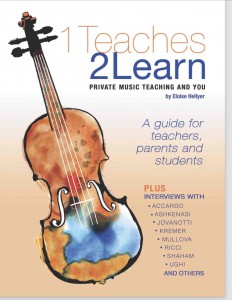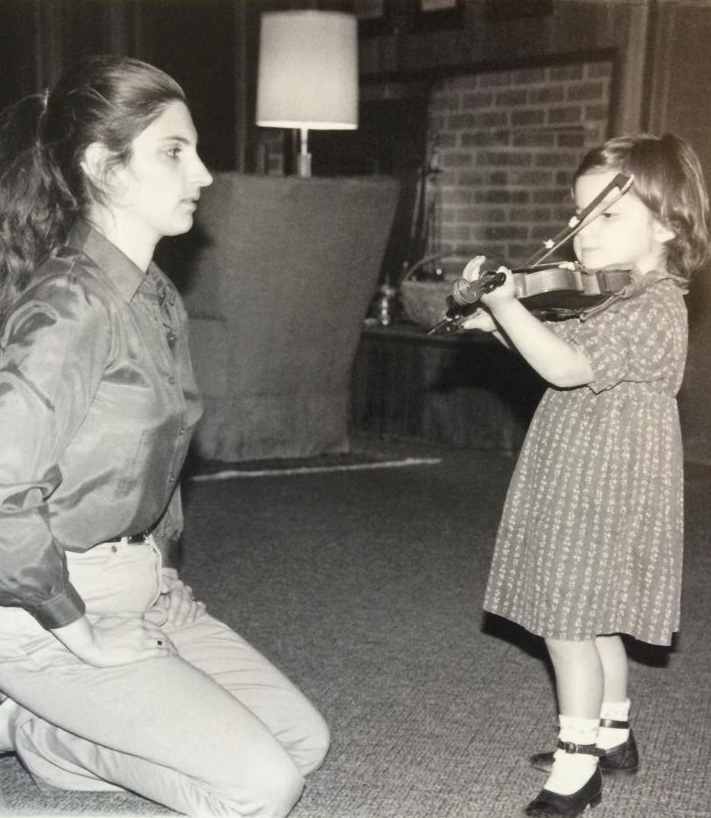Pride Goeth Before a Bad Lesson
One of the most important things a teacher can do for her young and inexperienced students is to teach them how to take a lesson. Especially if you teach beginners as I do, you know that sooner or later your students will leave you and go to other teachers for more advanced work. Or they might enroll in a conservatory, or go to college and major in music. In any case it is highly unlikely that your students will stay with you from the first bow stroke to their audition with the New York Phil; therefore we have to prepare them to take lessons from high-powered and maybe not as tolerant or understanding pedagogues as ourselves. So here is a list of important principles of lesson etiquette that I try to instill into my students over our years together to make sure they make a smooth transition from me to anyone else.
- Be on time. Get to your lesson early and have your violin and music ready. Important teachers take their work very seriously and don’t like to waste time. Yes, they’re getting paid anyway even if you dawdle, but this behavior annoys them as it shows lack of respect for the lesson and thus for the teacher.
- Do not play or start to play while the teacher is talking. She is trying to tell you something you probably don’t know and will get really irritated if she can’t say it or may just give up, which means you will have missed out on something important.
- Do not argue or talk back. A violinist friend told me the following story which shows what can happen when you do this: he once heard a “smart-aleck” student say to his teacher, “But that that’s not what my other teacher told me.” The result? The student was told to go back to his other teacher.
- Do not defend yourself or make excuses. There is no need – you are not under attack. The teacher is correcting what you did, not accusing you of a crime. Just take the instruction and do what the teacher says without explaining why you made the mistake, unless it’s REALLY pertinent, or saying that the error in question was unintentional. She doesn’t care why you think you did it (unless she asks you) or that it was accidental – it simply isn’t important. What’s important is to correct the mistake. Any protests or justifications on your part only wastes the teacher’s time and tries her patience.
- DO NOT CONTRADICT THE TEACHER. I put this in caps because I can’t emphasize it enough. If the teacher points out a mistake, or says you played the wrong note, even if you are in the right, KEEP QUIET. Don’t say, “No, I didn’t do that,” or just plain, “No.” This can really infuriate her. I heard a teacher in the conservatory here in Perugia tell a student once (quite forcefully) that a student has to say the teacher is right even when she isn’t. A rather profound thought that, when you think of it. You are there to take a lesson, to be filled with knowledge and this can’t happen if you put up interference by arguing or contradicting your teacher. It wastes time and energy – the teacher’s above all. Remember you are there to learn something, not show off. Once I corrected a 12 year-old student on something which she immediately played again perfectly without saying a word or even looking at me askance. I then realized that she had been right the first time and I myself had made the mistake. I congratulated her on this since it meant she understood what the lesson was all about. She didn’t waste a second of our time and energy discussing my correction. Personally, I may not mind if a student calls into question a correction, but other teachers do, so my students have to be prepared for that possibility. This does not mean you cannot say, however, “Oh, I’m sorry, I really thought that was an F sharp,” which gives your teacher a chance to see if she really was right. However, know that in 99.999% of cases the teacher IS right anyway so even this, although not offensive, is a waste of valuable time.
- Do not take criticism personally. This is a tough one. A mistake is a mistake and is only a mistake and your teacher’s correction must not be taken as a personal criticism. Your teacher is trying to correct what you do, not what or who you are. She is trying to help you play better. It can take time to learn to accept correction without taking it as a condemnation of you as a person, but learn it you must or you risk your teacher’s exasperation, which can have serious consequences, when you glower or cry because your feelings are hurt.
Notice that there is one thing in particular that causes most of the problems listed above: pride, in its negative sense – AKA hubris, vainglory, vanity, arrogance, false pride, cockiness or just an inordinate sense of self-esteem. It may be pride based on insecurity or feelings of low self-worth, but whatever the cause, it still manifests as the negative kind of pride which is a quality that has absolutely no place in a lesson. You might suggest that we should try to teach humility. That’s not easy. I think the best way is to make our students understand that a lesson is a flow of energy from teacher to student and back again and ANYTHING that interrupts that flow will compromise the lesson, make the teacher’s work more difficult, shorten her fuse and, as a result, the student will learn less. It’s in his best interest as a student to obey the above rules and try to adopt them into his learning life and above all to remember that a student has to be completely open to his teacher in order to really hear and get her teaching. If he goes into a lesson interested only in how good he looks and defending himself he will put up so many roadblocks to his teacher’s transmission that he will learn precious little. He will also probably wind up changing teachers quite frequently.
While I am tempted to nail this list to my studio door, it really wouldn’t help much. I have noticed that children who exhibit what I call prideful behavior are not always terribly happy and don’t enjoy their lives as students as much as their more relaxed companions; they suffer a lot as they are mostly centered on how good or bad they may look, how they feel, what they are or are not capable of. The importance of protecting their self-image or self-esteem claims so much of their energy that learning can be seriously compromised. We are teachers, not therapists, but what we can do is bolster our students’ self-confidence by giving them a solid instrumental base and prepare them to move on in their learning life with a firm understanding of how and what it means to take a lesson. it may take us years of consistency, constancy, empathy, understanding and a touch of rigor to convince these students to adopt all of the above rules and make them part of their way of being – or at least their way of taking a lesson. But that’s what we’re here for: not only to help our students learn, but to learn how to learn in the most efficient and respectful way possible – respectful towards their teachers, the learning process and ultimately themselves.
Post Author: Eloise Hellyer
With thanks again to Daniel Hooper. He knows why.
Share this:
Buy it on www.sharmusic.com - eBook format, avaliable worldwide, paperback in North America
COPYRIGHT
ABOUT
A music teacher’s thoughts and observations on the teaching and the study of a musical instrument, hoping to be of help to parents, students and teachers.
PHOTO
AWARDED TOP 25 VIOLIN BLOG
CATEGORIES
TAGS
ARCHIVES
-
Agosto 2022
Agosto 2023
Agosto 2024
April 2015
April 2016
April 2017
April 2019
April 2020
Aprile 2022
Aprile 2023
Aprile 2024
August 2014
August 2015
August 2016
August 2017
August 2018
August 2019
August 2021
December 2014
December 2015
December 2016
December 2017
December 2018
December 2019
December 2020
Dicembre 2022
Dicembre 2023
Dicembre 2024
Febbraio 2022
Febbraio 2023
Febbraio 2024
February 2015
February 2016
February 2018
February 2019
February 2020
February 2021
Gennaio 2022
Gennaio 2023
Gennaio 2024
Giugno 2022
Giugno 2022
Giugno 2023
Giugno 2024
January 2015
January 2016
January 2017
January 2018
January 2019
January 2020
July 2015
July 2017
July 2019
June 2016
June 2017
June 2018
June 2019
June 2020
June 2021
Luglio 2022
Luglio 2023
Luglio 2024
Maggio 2022
Maggio 2023
Maggio 2024
March 2015
March 2016
March 2017
March 2018
March 2019
March 2020
March 2021
Marzo 2022
Marzo 2023
Marzo 2024
May 2015
May 2016
May 2018
May 2019
May 2020
November 2014
November 2015
November 2016
November 2017
November 2018
November 2019
November 2021
Novembre 2022
Novembre 2023
Novembre 2024
October 2014
October 2015
October 2017
October 2018
October 2019
October 2020
October 2021
Ottobre 2022
Ottobre 2023
Ottobre 2024
September 2014
September 2015
September 2016
September 2018
September 2019
September 2020
September 2021
Settembre 2022
Settembre 2023
Settembre 2024
RECENT POSTS
Terry G and Me, or Terry Gilliam on Where (or What) Practicing the Piano Will Get You…
The Teaching We Don’t Do Is More Important Than We Think
Overwhelmingness or What Teaching and Motherhood* Have in Common
Cellphone Serenity
How to Build Your Reputation – the Kind You Want
Desperate Times, Desperate Measures. Or How to Deal With Your Strong-Willed Stubborn Student and Survive
“Why Does My Teacher Get So Frustrated?” Letter to a Perplexed Student
Mount Rush-no-more….And How to Get There
Realizzato con VelociBuilder - Another Project By: Marketing:Start! - Privacy Policy




